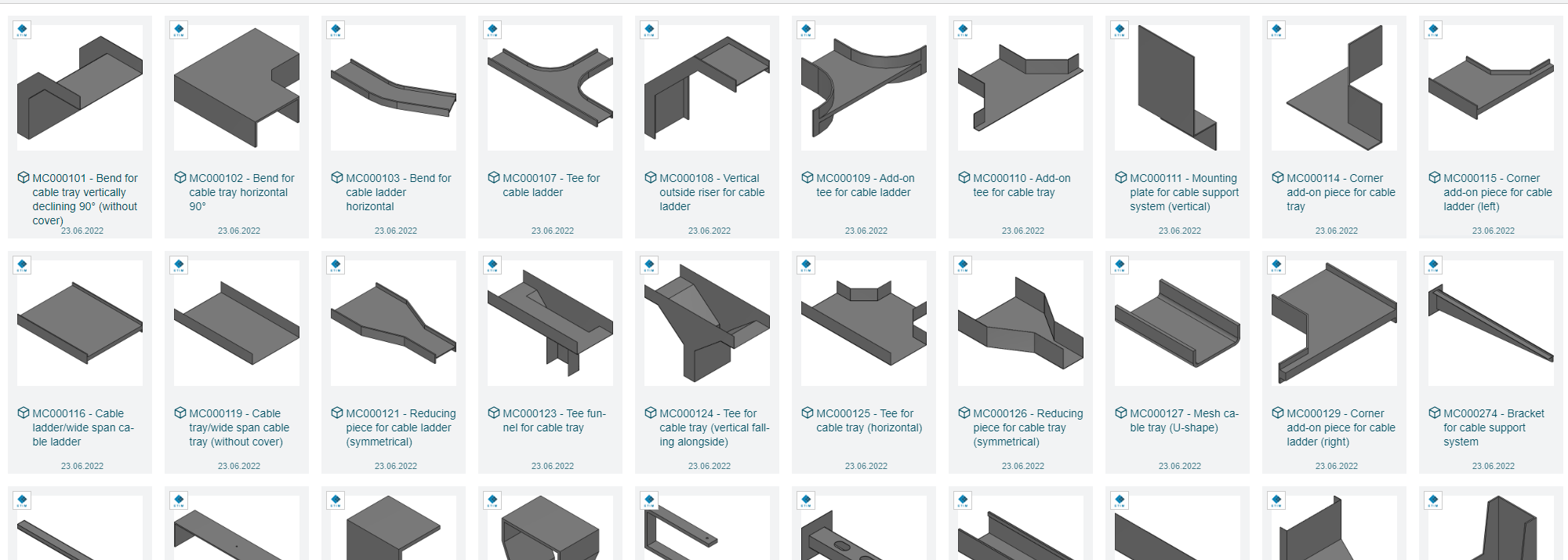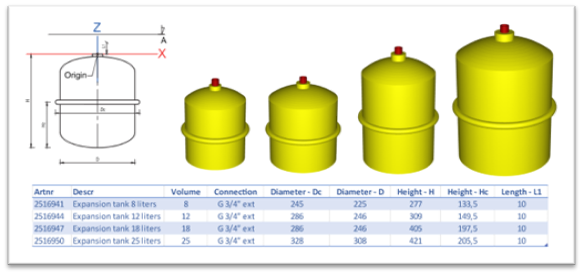ETIM International has serious ambitions for driving the adoption, further development and maintenance of ETIM Modelling Classes, or ETIM MC. First step to this end is introducing this extension to the ETIM classification model to a wider international public. So, what is ETIM Modelling Classes, exactly? Technical Director Marc Habets and Community Director Jeroen van der Holst are more than happy to explain.
Parametrics standardisation for BIM objects
As an extension of regular ETIM product classes, ETIM Modelling Classes standardize parametric content for BIM objects. Parametrisation of (3D) BIM models is especially suitable for repeatable products that come in many sizes and dimensions but are similar in shape, like fittings, cable trays and pumps. Many commercial BIM content libraries use this technology, but all kept reinventing the same parametric models for pumps, vessels, Junction boxes and windows. This results in manufacturers having to supply different data sets to different BIM platforms for exactly the same product.
Generic or manufacturer-specific: all in one parametric family
ETIM Modelling Class data is both vendor and BIM standard independent, so that manufacturers are relieved from the constant burden to choose between BIM object file formats, BIM standards and platforms. Marc Habets clarifies: “By standardising and separating the parametric content from appearance, manufacturers can now offer one data set with parameters for every BIM object, in any format. BIM objects in any library, on any software platform can be made as templates for consuming ETIM data. Without manufacturer-specific data these objects can serve generic design purposes, but they can also be made manufacturer-specific simply by loading a set of data.”
Van der Holst adds: “The benefits are mutual, since BIM modelers in the construction and installation industry only have to invest in one single uniform object library to their liking. Even if you do not have all the dimensions of a cable tray, pump, or expansion vessel, you can draw them in a generic shape with low, but recognizable level of detail. With these dimensions as a parametric variable, you can reuse the same BIM object in a variety of places, with different sizes, product numbers, technical specifications etc. Many of these dimensions were already part of ETIM, but the new Modelling Classes include reference drawings to serve as blueprints for the various BIM objects.”
 ETIM Modelling Classes, a brief history
ETIM Modelling Classes, a brief history
The first ideas behind ETIM Modelling Classes emerged around 2011 and came about in the BIM community in the Netherlands. Soon enough, the Dutch Installers association (Techniek Nederland) picked up on the idea. They invested in a pilot project in 2014-2015 to create a proof of concept, supported by the local standardisation body (Ketenstandaard Bouw en Techniek BV), BIM and MDM software houses, large installation contractors and a variety of manufacturers. By 2016, the first 360 standardized parametric BIM objects were defined for electrical, plumbing and HVAC installations.
The next step proved to be more difficult: showing the industry that these object definitions could be made into usable BIM objects. By 2018 the installation contractors, software houses, wholesalers and manufacturers involved upped their commitment and unitedly invested in building a centralised BIM object library called the Open Uniform Object Library, with a roadmap for a number of use cases.
As promising as it was, ETIM Netherlands and the Dutch installation industry soon concluded that the success of this project would largely depend on widespread international adoption. As a lot of manufacturers who will need to supply data have their headquarters abroad.
To secure its future, they came to an agreement with ETIM International to take over the ownership and further development and maintenance of the extension of the ETIM standard. Marc Habets adds: “We are happy to share that by now, we have over 500 objects described as ETIM Modelling Classes, and this number is growing fast. Internationally speaking, ETIM Germany have bought into ETIM Modelling Classes and are investing in a uniform object library of their own, but other ETIM country members like Norway, UK, France, Italy and Switzerland have taken an interest too, and are exploring their options.”
Modelling Classes and other BIM standards: integrability is key
Marc Habets stresses: “ETIM Modelling Classes are nothing more than a standardisation of parametric dimensions and some additional computational properties. They integrate very well into common BIM standards such as IFC, bSDD or ISO 16757. Moreover, any BIM software that can handle parametric objects, can build BIM template objects that are based on ETIM Modelling Classes. The ETIM community (suppliers and wholesalers) does not care how exactly the BIM community uses their BIM objects as long as they use supplier-validated data. After all, that is the whole idea behind ETIM Modelling Classes: they are meant to be used in BIM object libraries.”
Use cases
By integrating ETIM Modelling Classes into your BIM library, BIM software, PIM system, within the business vertical, you can:
- Start your design with generic BIM objects and create manufacturer-specific results, simply by exchanging the data object.
- Realize real-time validation of manufacturer-specific objects in BIM models, according to the latest data set as provided by the manufacturer.
- Find technically compatible, equivalent alternative products based on ETIM Classes and its features.
- As a manufacturer, supply BIM content merely by supplying product data through existing workflows, independent of any software vendor or technology.
- Link to supply chain and other standardised data (such as standard installation time tables).
Addressing the elephant in the room
Van der Holst: “when you talk to BIM modelers, obtaining good quality content is always an issue. Either the file format is wrong, the geometry to heavy and too detailed, or the data dictionary fails. I myself come from a manufacturer background and had to deal with other problems. The lack of resources to cover all file format requirements and BIM-platforms, for example. I know from experience that many small and medium sizes companies struggle to supply any BIM content. They either lack trained staff, budget, or both. Adding a few sizes to their product data, however, should never be a problem. And for the same reasons, we should also acknowledge that no BIM library, platform, or wholesaler will be able to reach a 100% coverage in terms of supplying BIM content of all that is available on the market. It is too much work to do that on your own. This should become a combined effort supported by trade associations.
By introducing the ETIM Modelling Classes extension to our open standard, we hope to simplify things and create an even more inviting environment for data exchange. By enabling manufacturers to just focus on sending product data through existing channels and by communicating a few geometric sizes belonging to a standardised parametric model description. And as long as everybody adopts to ETIM Modelling Classes standardised parametric objects, BIM modelers can work in whatever software on whatever platform they like. Our ultimate goal is to eliminate all copy-pasting and conversion activities around BIM objects. Making copies and converting or reinterpreting product features can lead to incorrect, erroneous product data. And in the building and installation sector we all know what that could lead to. With ETIM MC we enable the building and installation sector to further automate the flow of data from the manufacturer straight into BIM models.”
Interesting links
- The official site of the open Uniform Object Library project
- Open UOB being discussed on youtube (dutch language)
https://www.youtube.com/watch?v=eYdxn8444yI
https://www.youtube.com/watch?v=DpzT7N4kYWU
https://youtu.be/Z6-ihp_bNAY
- The ETIM-BIM initiative of ETIM Germany
https://etim.de/etim-bim/
https://www.bauen-aktuell.eu/etim-klassifizierte-produkte-mit-bim-planungsdaten-anreichern/
- Elektroforeningen in Norway discusses ETIM Modelling Classes plans with members
https://www.efo.no/nyheter/efojulemotet-2022
- ETIM Modelling Classes being discussed at the EDA Digitalisation Forum
https://www.eda.org.uk/news/digitalisation-forum-and-data-awards-2022/
- ETIM MC being discussed on the website of ETIM UK
https://www.etim-uk.co.uk/news/etim-mc/
- ETIM MC official standardisation guidelines
- ETIM MC explained on youtube

 ETIM Modelling Classes, a brief history
ETIM Modelling Classes, a brief history